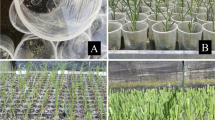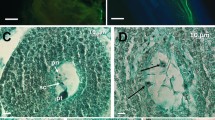Abstract
Successful selection of interspecific hybrid progenies with superior ability to regenerate shoots from apical meristems was performed in sunflower which now allows for the development of lines for improved biotechnological applications. Early generations of interspecific hybrids originating from crosses between the two H. annuus CMS lines ‘HA89’ and ‘Baso’, and 9 wild species were screened for their ability to regenerate in vitro. Evaluation of 36 progenies allowed to identify seven progenies from crosses involving H. mollis, H. giganteus, H. strumosus, and H. decapetalus which showed a significantly higher regeneration potential than the commercial hybrid ‘Albena’ regarding the number of shoots per explant. Among these progenies, 47.2 to 62.4% of explants produced shoots with an average of 2.3 to 3.5 shoots per cultured explant. Regeneration in vitro was significantly determined by the genotype. More than half of the investigated interspecific hybrids performed better than the inbred ‘HA89’ demonstrating that the high regeneration potential available in the wild species can be efficiently transferred to cultivated sunflower. The seven progenies with high regeneration potential in vitro were characterised by agronomic performance in the field. Two of the interspecific hybrids derived from H. strumosus and H. decapetalus not only showed a superior regeneration potential but also proved to be competitive to commercial hybrids with regard to important agronomic traits, e.g. fat content and TGW.
Similar content being viewed by others
References
Alibert, G., C. Aslane-Chanabé & M. Burrus, 1994. Sunflower tissue and cell cultures and their use in biotechnology. Plant Physiol Biochem 32: 31-44.
Bohorova, N.E., A. Atanasov & G. Georgieva-Todorova, 1985. In vitro organogenesis, androgenesis and embryo-culture in the genus Helianthus L. Z Pflanzenzüchtg 95: 33-44.
Bundessortenamt, 1994. Richtlinien für die Durchführung von landwirtschaftlichen Wertprüfungen und Sortenversuchen. Strothe, Hannover, Germany.
Burrus, M., C. Molinier, C. Himber, R. Hunold, R. Bronner, P. Rousselin & G. Hahne, 1996. Agrobacterium-mediated transformation of sunflower (Helianthus annuus L.) shoot apices: transformation patterns. Molec Breed 2: 329-338.
Friedt, W., 1992. Present state and future prospects of biotechnology in sunflower breeding. In: G. Seiler (Ed.), Field Crops Research 30, pp. 425-442. Elsevier Sci Publ, Amsterdam.
Friedt, W., T. Nurhidayah, T. Röcher, H. Köhler, R. Bergmann & R. Horn, 1997. Haploid production and application of molecular methods in sunflower (Helianthus annuus L.). In: S.M. Jain (Ed.), In vitro haploid production in higher plants, pp. 17-35. Kluwer Academic Publishers, Amsterdam.
Gürel, A., K. Nichterlein & W. Friedt, 1991. Shoot regeneration from anther culture of sunflower (Helianthus annuus L.) and some interspecific hybrids is affected by genotype and culture procedure. Plant Breeding 106: 68-76.
Hahne, G., 1994. Sunflower. In: K. Wang, A. Herrera-Estrella & M. van Montagu (Eds.), Transformation of Plants and Soil Microorganisms, pp. 137-149. Cambridge Univ Press, Cambridge.
Henn, H.J., R. Wingender & H. Schnabl, 1998. Regeneration of fertile plants from Helianthus nuttallii T.& G. and Helianthus giganteus L. mesophyll protoplasts. Plant Cell Rep 18: 288-291.
Ivanov, P., J. Encheva & I. Ivanova, 1998. A protocol to avoid precocious flowering of sunflower plantlets in vitro. Plant Breeding 117: 582-584.
Knittel, N., V. Gruber, G. Hahne & P. Lenee, 1994. Transformation of sunflower (Helianthus annuus L.): a reliable protocol. Plant Cell Rep 14: 81-86.
Konov, A., R. Bronner, K. Skryabin & G. Hahne, 1998. Formation of epiphyllous buds in sunflower (Helianthus annuus L.): induction in vitro and cellular origin. Plant Sci 135: 77-86.
Korell, M., L. Brahm, R. Horn & W. Friedt, 1996a. Interspecific and intergeneric hybridisation in sunflower breeding. I. General breeding aspects. Plant Breeding Abstr 66: 925-931.
Korell, M., L. Brahm, W. Friedt & R. Horn, 1996b. Interspecific and intergeneric hybridisation in sunflower breeding. II. Specific uses of wild germplasm. Plant Breeding Abstr 66: 1081-1091.
Krasnyanski, S., Z. Polgar, G. Nemeth & L. Menczel, 1992. Plant regeneration from callus and protoplast cultures of Helianthus giganteus L. Plant Cell Rep 11: 7-10.
Kräuter, R., A. Steinmetz & W. Friedt, 1991. Efficient interspecific hybridization in the genus Helianthus via 'embryo rescue' and characterization of the hybrids. Theor Appl Genet 82: 521-525.
Laparra, H., M. Burrus, R. Hunold, B. Damm, A. Bravo-Angel, R. Bronner & G. Hahne, 1995. Expression of foreign genes in sun-flower (Helianthus annuus L.)-evaluation of three gene transfer methods. Euphytica 85: 63-74.
Murashige, T. & F. Skoog, 1962. A revised medium for rapid growth and bio assays with tobacco tissue cultures. Physiol Plant 15: 473-497.
Nurhidayah, T., R. Horn, T. Röcher & W. Friedt, 1996. High regeneration rates in anther culture of interspecific sunflower hybrids. Plant Cell Rep 16: 167-173.
Pugliesi, C., P. Megale, F. Ceccioni & S. Baroncelli, 1993a. Organogenesis and embryogenesis in Helianthus tuberosus and in the interspecific hybrid Helianthus annuus × Helianthus tuberosus. Plant Cell Tiss Org Cult 33: 187-193.
Pugliesi, C., M.G. Biasini, M. Fambrini & S. Baroncelli, 1993b. Genetic transformation by Agrobacterium tumefaciens in the interspecific hybrid Helianthus annuus × Helianthus tuberosus. Plant Sci 93: 105-115.
Rieseberg, L.H., D.M. Arias, M.C. Ungerer, C.R. Linder & B. Sinervo, 1996. The effects of mating design on introgression between chromosomally divergent sunflower species. Theor Appl Genet 93: 633-644.
Sarrafi, A., J.P. Roustan, J. Fallot & G. Alibert, 1996. Genetic analysis of organogenesis in the cotelydons of sunflower (Helianthus annuus L.). Theor Appl Genet 92: 225-229.
Schrammeijer, B., P.C. Sijmons, P.J.M. van den Elzen & A. Hoekema, 1990. Meristem transformation of sunflower via Agrobacterium. Plant Cell Rep 9: 55-60.
Weber, S., M.K. Zarhloul & W. Friedt, 2000. Modification of oilseed quality by genetic transformation. In: K. Esser, J.W. Kadereit, U. Lüttge & M. Runge (Eds.), Prog Bot 62, in press.
Author information
Authors and Affiliations
Rights and permissions
About this article
Cite this article
Weber, S., Horn, R. & Friedt, W. High regeneration potential in vitro of sunflower (Helianthus annuus L.) lines derived from interspecific hybridization. Euphytica 116, 271–280 (2000). https://doi.org/10.1023/A:1004061632736
Issue Date:
DOI: https://doi.org/10.1023/A:1004061632736




